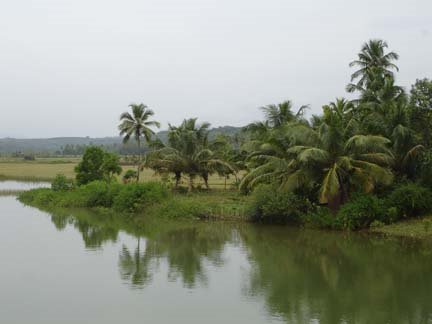
A wooden nagaa under construction at Ullal. A white arrow inserted shows the size of a man for comparison
Panemangalore and Pandimar, the place names, hold key to the ancient boat based trade culture of the Karavali. The word 'Pandi' (= a large cargo boat) appears to have been connected with ancient rulers of the south known as Pandyas. Apart from the Pandya Kings that ruled parts of Tamilandu during historical period, several Alupa Kings of Tulunadu have adorned the title of Pandya. The 'Pandya' surname appears to have been derived from the word 'Pāndi'. The capital of Pandyas, the original Madhurai, as well as those of Alupas were coastal port towns. It is logical to presume that ancient rulers of the coastal lands were affluent traders who employed large boats to ferry their merchandise to various destinations. Thus the ancient Tulu -Dravida coastal people were proficient in building huge boats to transport food-grains and other items on sea-route and coastal fluvial courses . Large tree trunks woods were cut down in the dense forests of Western Ghats and were transported downstream to coastal boat making centres through the major rivers like Nethravati.
Oda
The common 'Oda'(d as in dog) is a narrow linear wooden boat employed to traverse through rivers as well as used for fishing in the sea. On the analogy of morphology (shape) of Oda, the Tulu village name /suffix 'Odi' (as in Odipu, Posodi, Niddodi etc) can be described as a lane like habitation with houses arranged in a linear fashion.Odi can have several other shades of meaning like sloping land:it also may be an equivalent of the word 'Oli'(Compare village names 'Airoli' with 'Airodi'). As suggested by Hosabettu Viswanath the 'Oda' apparently evolved later into 'Ota', the run.
Besides 'Oda ', there are a number of words that describe large sized cargo boats in Tulu. Words like Pāndi, Koti, Nagā, Manji, Padavu and Kappāl were in usage to refer to large cargo boats implying that the ancient Tulu people were proficient in marine trade and navigation. Note that most of these words also reflect a large size or a huge number.
Pāndi , Pandya
Pandi is large boat used to carry merchandise and the boat-owner was usually known as Pandia or Pāndya. The legend of Bhutala Pandya highlights the life and times of a Pāndi owner or Pāndya. There is a suggestion that some of these Pandia were rich fishermen who were also experts in sea-faring and sailing cargo boats.
Pāndyas of Tamilnadu as well as Tulunadu (Alupa Kings)adopted the insignia of twin fishes. Adoption of this insignia might have been conncted to their heritage of fisherfolk /sailor culture or it may have been derived from the roots of fish worship cult of Sindhu- Saraswathi (Indus valley) civilization.
Sediyapu Krishna Bhat suggested that the surname Pandya or Pandia was originally applied to the owner of the large boat known as Pandi. Pandya were one of the the earliest dynasties that ruled ancient Tamilnadu. He has also proved that the word Pandi was once a Dravida word widespread in southern India. The place names Pondicherry and Pondi Bazar in Tamil areas are obviously the relics of the ancient Dravida word Pāndi.
Pandi probably was known in Gujarat coast also as pointed out by Sediyapu. The 'Pānde' surname popular in northern India might have been an offshoot of the word 'Pāndi'.
Bandi
Another interesting point is that the word 'Pandi' is related to or evolved to 'Bandi' (p>b transition) which now literally represents a wheeled vehicle, but originally the word banDa meant goods or merchandise and therefore 'banDi' meant a goods transport vehicle. Note the word 'banDasāle' (d pronounced as in 'dog') in Tulu represents a store-house.
Koti
Koti (t pronounced as in tea) is a large boat like Pandi. The funny expression 'KoTi or PānDi' is used by Tulu people usually as a pun. A Koti also represents a store-house or large number ( a crore or one hundred lakhs). However the personal name of 'Koti' (of Koti- Chennya fame)is said to have been derived from the name of deity Kotilingeswara.
Nagā
Nagāa also means a hill. The word was applied to (1) a hill-like large boat (2) a boat carrying valuable goods that brought cash to the owner of the boat upon trade transactions. The word nagā also evolved later to represent valuables like gold and jewelry ( as in 'naga nattu' ) or currency (as in 'naga nānya'), The Dravida word for cash 'nagad' is also derived from the word 'nagā'.
Manji
The words 'manjā' or 'manji' in Tulu meant a raised structure or elevated land and it was also applied to large sized boats. So the original word coined by the Nātha monks at Kadire (Mangalore) for the deity Manjinatha (later refined to 'Manjunatha') actually referred to the God of the heights, the heights possible connoted either the Mount Kailas ( the Himalayas) and/or the 'manja' or 'manji' (elevated plateau of the Kadire hills.
Of course there are words apparently of different origin but sounding similar to 'manji' with dissimilar meanings like (1) 'manj' or 'manji', the dew or fog and (2) 'mānji' a flat fish, known also as pamphret.
®


